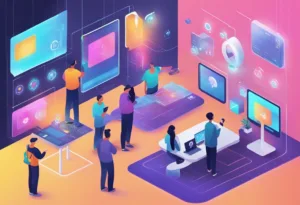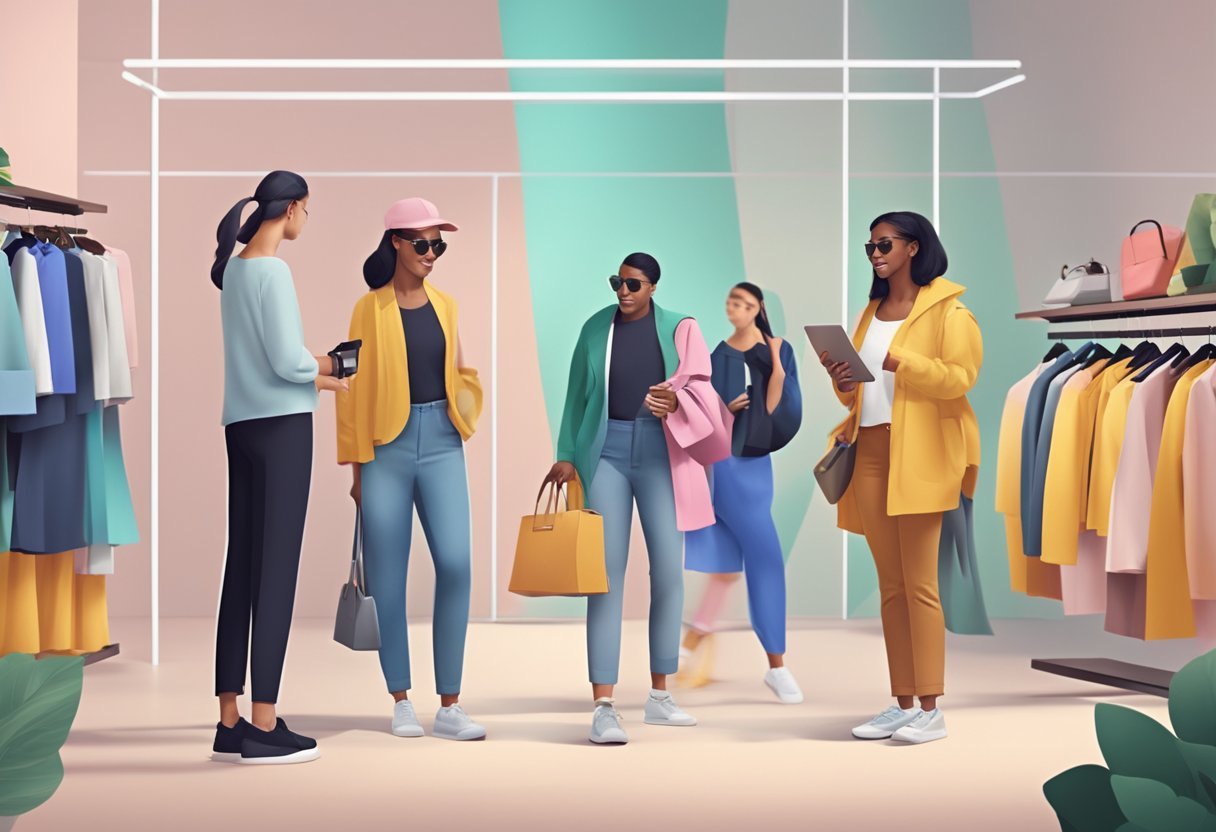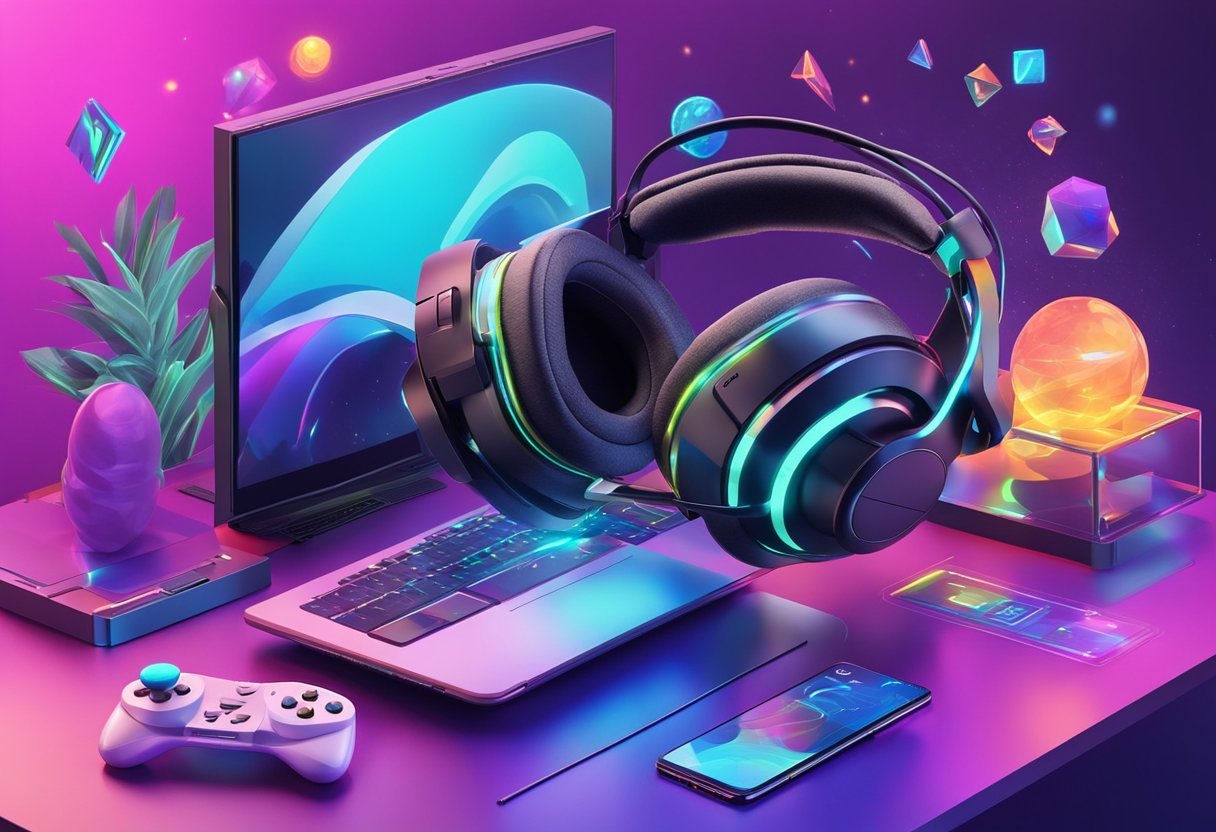Augmented reality shopping experience is a relatively new technology that is changing the retail landscape. AR shopping allows customers to visualize products in a virtual environment, try them on, and personalize them before making a purchase. As a result, AR shopping experience is becoming increasingly popular among consumers, especially those who prefer online shopping. In this blog post, I will share with you the top 15 brands offering augmented reality shopping experience and their use cases
The technology behind AR shopping involves the use of a smartphone or a tablet to create a virtual environment that overlays the real world. The device’s camera captures the real world, and the AR app overlays virtual objects on top of it. This technology is made possible by the use of computer vision, which enables the device to recognize and track the real world environment and the virtual objects.
AR shopping experience use cases include virtual try-ons for clothing and accessories, home decor visualization, and product customization. These use cases are transforming the way customers shop, making it more convenient, personalized, and fun. Retailers who adopt AR shopping experience can expect to see an increase in customer engagement, conversion rates, and sales.
Key Takeaways
- AR shopping experience allows customers to visualize products in a virtual environment, try them on, and personalize them before making a purchase.
- The technology behind AR shopping involves computer vision and the use of a smartphone or a tablet to create a virtual environment that overlays the real world.
- AR shopping experience use cases include virtual try-ons for clothing and accessories, home decor visualization, and product customization. Retailers who adopt AR shopping experience can expect to see an increase in customer engagement, conversion rates, and sales.
The Evolution of AR Shopping
Shopping has been an integral part of human life for centuries. It has evolved significantly over time, from the early days of barter trade to the modern-day online shopping experience. The retail sector has undergone a massive transformation, and the emergence of technology has played a significant role in shaping the shopping experience.
From Brick-and-Mortar to E-Commerce
The traditional shopping experience involved visiting physical stores and browsing through the products to make a purchase. However, with the advent of e-commerce, the shopping experience has shifted online. Customers can now shop from the comfort of their homes, and the online shopping experience has become increasingly popular due to its convenience and accessibility.
The pandemic has further accelerated the shift towards online shopping. With the need for social distancing, many customers have opted for online shopping, and retailers have had to adapt to meet the changing demands of the market.
Rise of Augmented Reality Shopping
Augmented reality shopping is the latest innovation in the retail sector, offering customers a unique and immersive shopping experience. With augmented reality, customers can visualize products in a more realistic and interactive way, allowing them to make more informed purchase decisions.
Digital marketing has played a crucial role in promoting augmented reality shopping. Retailers can use social media platforms to showcase their products and provide customers with an augmented reality shopping experience. This has helped to increase customer engagement and drive sales.
Shopping has come a long way, from the early days of barter trade to the modern-day online shopping experience. The emergence of technology has played a significant role in shaping the shopping experience, and the rise of augmented reality shopping is the latest innovation in the retail sector.
Technology Behind AR Shopping
Augmented Reality (AR) shopping is a technology that combines physical and digital shopping experiences. It allows customers to virtually browse and explore products using AR technology. AR technology overlays digital content onto the user’s real-world environment, enabling customers to try on and test products through an electronic device such as a smartphone or smart glasses.
AR Hardware and Software
AR shopping requires hardware and software components to function. The hardware component includes a device with a camera, such as a smartphone or smart glasses. The camera captures the user’s real-world environment, and the software overlays digital content onto the captured image. AR technology can be integrated into smartphones, smart glasses, or other wearable devices.
AR shopping software is developed using AR development tools such as Unity and Lens Studio. Unity is a cross-platform game engine that can be used to create AR applications. Lens Studio is a free AR development tool that allows developers to create AR experiences for Snapchat.
3D Content Creation and Management
AR shopping requires 3D models of products to be created and managed. 3D models are digital representations of physical objects that can be viewed and manipulated in 3D space. The 3D models are used to create digital content that is overlaid onto the user’s real-world environment.
The 3D models are created using 3D modeling software such as Blender or Maya. The models are then optimized for use in AR applications. 3D models can be managed using content management systems such as Sketchfab or Unity Asset Store.
AR shopping is a technology that combines physical and digital shopping experiences, allowing customers to virtually browse and explore products using AR technology. The technology requires hardware and software components, including a device with a camera, AR development tools such as Unity and Lens Studio, and 3D models of products created using 3D modeling software such as Blender or Maya. Content management systems such as Sketchfab or Unity Asset Store can be used to manage 3D models.
15 Brands Offering Augmented Reality Shopping Experience

- IKEA
- Sephora
- Warby Parker
- LEGO
- Gucci
- Amazon
- ASOS
- Wayfair
- L’Oréal
- Home Depot
- Zara
- Timberland
- Burberry
- Gap
- Nike
IKEA
IKEA’s augmented reality shopping experience allows customers to visualize furniture and home decor in their own living spaces before making a purchase. The Swedish retailer’s app uses AR technology to project true-to-scale 3D models of their products into any room, giving a realistic impression of how the items will fit and look. This helps in making more informed decisions, saving time and reducing the likelihood of returns. By offering this innovative solution, IKEA enhances the customer experience, making it a leader among augmented reality stores in the home furnishings sector.
Sephora
Sephora offers an augmented reality shopping experience that revolutionizes the way customers try on makeup. Through their Virtual Artist app, users can test different cosmetics on their own face in real-time, using the camera on their smartphone.
This AR experience includes a wide range of products, from lip colors to eyeshadows, providing a hygienic and convenient way to experiment with new looks. Sephora’s use of AR technology elevates the beauty shopping experience, making it one of the most innovative augmented reality stores in the industry.
Warby Parker
Warby Parker’s augmented reality shopping experience is transforming the way customers shop for eyewear. Their Virtual Try-On feature enables users to see how different frames will look on their faces through their smartphone screens.
This personalized experience ensures that customers find the perfect pair of glasses that suit their style and facial features. Warby Parker’s innovative approach to AR makes it a standout among augmented reality stores, offering a convenient and enjoyable eyewear shopping experience.
LEGO
LEGO’s augmented reality shopping experience brings the joy of building to life before a purchase is made. Through AR-enabled apps, customers can see 3D models of LEGO sets come to life, allowing them to interact with the finished product in a virtual space.
This immersive experience not only engages children but also helps parents understand the value of the set. As one of the leading augmented reality stores in the toy industry, LEGO provides an innovative and playful shopping experience for customers of all ages.
Gucci
Gucci’s augmented reality shopping experience allows customers to try on shoes virtually using their smartphone camera. The luxury fashion brand’s AR technology lets users see how different styles and colors of footwear look on their feet from the comfort of their own home.
This innovative approach to shopping enhances the customer experience by providing a convenient and personalized way to explore Gucci’s high-end products. As an augmented reality store, Gucci sets a high standard for luxury retail in the digital age.
Amazon
Amazon’s augmented reality shopping experience enhances the convenience of online shopping by allowing customers to visualize products in their own environment. With AR View, users can see how electronics, appliances, toys, and more will look and fit in their homes.
This feature helps in reducing the uncertainty that often comes with online shopping, leading to greater customer satisfaction. Amazon’s position as an augmented reality store further solidifies its reputation as a leader in e-commerce innovation.
ASOS
ASOS has introduced an augmented reality shopping experience that enables customers to see garments on different body types before purchasing. This virtual catwalk feature helps shoppers to better gauge how clothing will look on them, providing a more realistic online fashion shopping experience. ASOS’s use of AR technology addresses the challenge of representing diverse body shapes and sizes, making it a pioneering augmented reality store in the fashion industry.
Wayfair
Wayfair’s augmented reality shopping experience allows customers to visualize furniture and decor in their homes with incredible accuracy. Using the Wayfair app, users can place 3D models of products in their space to determine if the style, color, and size are right for their room.
This interactive feature minimizes the guesswork involved in home decorating and ensures that customers are confident in their purchases. As an augmented reality store, Wayfair is enhancing the home improvement shopping journey with technology.
L’Oréal
L’Oréal offers an augmented reality shopping experience through their Makeup Genius app, which allows customers to try on makeup virtually. This AR technology gives users the ability to test various products and shades in real-time, providing a personalized and mess-free way to explore different looks. As an augmented reality store, L’Oréal is changing the beauty industry by offering a convenient and innovative way to shop for cosmetics.
Home Depot
Home Depot’s augmented reality shopping experience helps customers with home improvement projects by allowing them to visualize how products will look in their space. From paint colors to appliances, users can make more informed decisions by seeing products in their actual environment. Home Depot’s use of AR technology simplifies the DIY process, making it a go-to augmented reality store for home renovators.
Zara
Zara’s augmented reality shopping experience brings fashion to life by showcasing models wearing different outfits when customers point their smartphones at certain store displays or Zara AR app icons. This feature provides an interactive and engaging way to view the latest collections, making Zara a forward-thinking augmented reality store in the fast-fashion sector.
Timberland
Timberland’s augmented reality shopping experience enables customers to try on footwear virtually. This innovative approach allows shoppers to see how different styles of boots and shoes look on their feet without the need to physically try them on, offering a convenient and time-saving shopping experience. As an augmented reality store, Timberland is enhancing the way customers interact with their products.
Burberry
Burberry’s augmented reality shopping experience allows customers to add an interactive dimension to their shopping by using AR to explore products and the brand’s heritage. This immersive experience provides a deeper connection to the Burberry brand and helps customers visualize products in a new way. As an augmented reality store, Burberry is at the forefront of combining luxury fashion with cutting-edge technology.
Gap
Gap’s augmented reality shopping experience, known as the DressingRoom app, enables customers to try on clothing virtually. Users can select a mannequin that matches their body shape and size to see how different outfits will look, making the online shopping experience more personalized and accurate. Gap’s initiative as an augmented reality store aims to reduce return rates and increase customer satisfaction.
Nike
Nike’s augmented reality shopping experience offers customers the ability to try on sneakers virtually through their smartphone cameras. This feature, called Nike Fit, helps shoppers find the perfect size and style by seeing how the shoes look on their feet in real-time. As an augmented reality store, Nike is revolutionizing the footwear shopping experience by blending physical and digital worlds.
Augmented Reality Shopping Experience Use Cases

Try-before-you-buy
One of the most significant advantages of augmented reality shopping is the ability to try before you buy. Augmented reality allows customers to see how a product will look or fit in their home or on their body before making a purchase. This feature is particularly useful for customers who are hesitant to buy a product without seeing it in person or trying it on. With augmented reality, customers can see how furniture will look in their home, how clothes will fit on their body, and even how makeup will look on their face. This feature can help reduce returns and increase customer satisfaction.
Product Visualization
Augmented reality shopping also provides customers with a more immersive product visualization experience. With augmented reality, customers can see products in 3D and from different angles. This feature can help customers get a better understanding of the product and its features. For example, customers can see how a piece of furniture will look in their home from different angles or see how a new car will look from different perspectives. This feature can help increase customer engagement and sales.
Fun and Engagement
Augmented reality shopping can also be a fun and engaging experience for customers. With augmented reality, customers can interact with products in new and exciting ways. For example, customers can play games or puzzles using augmented reality or see how a new outfit will look while walking down the runway. This feature can help increase brand awareness and customer loyalty.
Virtual Presence
Finally, augmented reality shopping can provide customers with a virtual presence. With augmented reality, customers can attend events or visit stores virtually. This feature can be particularly useful for customers who are unable to attend events in person or who live far away from a physical store. This feature can help increase customer engagement and sales.
Augmented reality shopping provides customers with a more immersive and engaging shopping experience. With augmented reality, customers can try before they buy, visualize products in 3D, have fun and engaging experiences, and even have a virtual presence. As augmented reality technology continues to improve, the possibilities for augmented reality shopping experiences are endless.
AR Shopping Experiences

Augmented Reality (AR) technology has transformed the way people shop. It allows customers to visualize how products will look in their homes or on their bodies before making a purchase. This technology has been implemented in various industries, including fashion, beauty, and home decor.
Virtual Try-On for Fashion and Beauty
Virtual Try-On is a popular AR feature used in the fashion and beauty industry. It allows customers to try on clothing and makeup virtually. This feature has been implemented by various brands, including Sephora and L’Oreal. Customers can upload their photos and use the AR technology to see how different makeup looks or clothing items will look on them.
Virtual Try-On technology has also been implemented by various clothing brands. Customers can use their phone cameras to scan their bodies and create a 3D model of themselves. They can then use this model to try on different clothing items virtually. This feature has been implemented by brands such as H&M and Zara.
Furniture and Home Decor Visualization
AR technology has also been implemented in the furniture and home decor industry. It allows customers to visualize how furniture and home decor items will look in their homes before making a purchase. Customers can use their phone cameras to scan their living room or any other room in their home. They can then use the AR technology to place different furniture items and home decor items in the room virtually.
This feature has been implemented by various brands, including Walmart and IKEA. Customers can use the AR technology to see how different furniture items will look in their homes before making a purchase. This has helped customers make more informed decisions when it comes to home furnishing and has reduced the likelihood of product returns.
AR technology has transformed the shopping experience for customers. It has allowed customers to try on clothing and makeup virtually and visualize how furniture and home decor items will look in their homes before making a purchase. This technology has been implemented by various brands and has helped customers make more informed decisions when it comes to shopping.
Impact on Retailers and Consumers
Augmented reality (AR) has transformed the way people shop, and it has had a significant impact on both retailers and consumers. By enhancing customer engagement and influencing purchasing decisions, AR has created a new retail experience that provides value and convenience to customers.
Enhancing Customer Engagement
AR has revolutionized the customer journey by providing an immersive shopping experience that allows customers to visualize products in the real world. Retailers can use AR to create interactive product catalogs, which allow customers to view products from different angles and in different contexts. This enhances customer engagement by providing a more personalized shopping experience.
AR also enables retailers to create gamified experiences that encourage customers to spend more time in-store or online. By creating interactive games that incorporate products, retailers can increase customer engagement and drive sales. For instance, a retailer could create an AR scavenger hunt that encourages customers to explore the store and interact with products.
Influencing Purchasing Decisions
AR has a significant impact on purchasing decisions by providing customers with a more accurate representation of products. By using AR, customers can view products in their real-world context, which helps them make more informed purchasing decisions. This is particularly important for products that are difficult to visualize, such as furniture or home decor.
AR also helps customers to visualize how products will look in their homes or workplaces, which reduces the risk of post-purchase regret. By providing a more accurate representation of products, AR helps to increase customer satisfaction and reduce the number of returns.
AR has transformed the way people shop, and it has had a significant impact on both retailers and consumers. By enhancing customer engagement and influencing purchasing decisions, AR has created a new retail experience that provides value and convenience to customers. Retailers that embrace AR will be able to provide a more personalized shopping experience and increase customer satisfaction and sales.
Future Trends in AR Shopping
As technology continues to advance, the future of augmented reality (AR) shopping is looking bright. Emerging technologies such as 3D commerce, immersive shopping experiences, and personalization are set to revolutionize the way people shop. This section will explore some of the future trends in AR shopping.
Emerging Technologies in Retail
The global population of smartphone users is increasing rapidly, and this has led to the growth of e-commerce. With the rise of e-commerce, retailers are looking for new ways to engage customers and provide a seamless shopping experience. AR technology can help retailers achieve this goal by providing an immersive shopping experience.
One of the emerging technologies in retail is 3D commerce. This technology allows customers to view products in 3D, which provides a more realistic representation of the product. With 3D commerce, customers can view the product from all angles, which can help them make a more informed purchasing decision.
Another emerging technology in retail is immersive shopping experiences. This technology provides customers with an interactive shopping experience by allowing them to virtually try on products. Immersive shopping experiences can help customers make a more informed purchasing decision and reduce the likelihood of returns.
Personalization and the Role of Data
Personalization is becoming increasingly important in the world of e-commerce. With the rise of big data, retailers can now collect and analyze customer data to provide a more personalized shopping experience. AR technology can help retailers achieve this goal by providing personalized product recommendations.
The role of data in personalization cannot be overstated. By collecting and analyzing customer data, retailers can gain insights into customer behavior and preferences. This data can then be used to provide personalized product recommendations to customers.
The future of AR shopping is looking bright. Emerging technologies such as 3D commerce and immersive shopping experiences, combined with the power of personalization and data, are set to revolutionize the way people shop. As retailers continue to embrace AR technology, customers can expect to enjoy a more immersive and personalized shopping experience.
Frequently Asked Questions
How do AR shopping apps enhance the in-store experience for customers?
AR shopping apps provide customers with a unique shopping experience by allowing them to try on products virtually. Customers can view a product in 3D, try it on, compare different sizes, and even customize the product with different colors and materials. This technology provides customers with a more personalized and interactive shopping experience, which can lead to increased customer satisfaction and loyalty.
What are some successful examples of augmented reality in retail?
One successful example of augmented reality in retail is the Sephora Virtual Artist app. This app allows customers to try on different makeup products virtually, which can help them make more informed purchasing decisions. Another example is the IKEA Place app, which allows customers to see how furniture will look in their home before making a purchase.
How has augmented reality impacted sales within the retail sector?
Augmented reality has the potential to increase sales within the retail sector by providing customers with a more engaging and personalized shopping experience. By allowing customers to try on products virtually, retailers can increase the likelihood of customers making a purchase. Augmented reality can help retailers reduce returns by allowing customers to see how a product will look in their home before making a purchase.
In what ways has Walmart integrated augmented reality into their shopping experience?
Walmart has integrated augmented reality into their shopping experience by using it to enhance their product displays. For example, they have used augmented reality to create interactive displays for their toy section, which allows customers to see how certain toys work before making a purchase. Walmart has also used augmented reality to create interactive displays for their home goods section, which allows customers to see how certain products will look in their home.
What are the benefits of AR in fashion e-commerce platforms?
AR in fashion e-commerce platforms can provide customers with a more personalized and interactive shopping experience. By allowing customers to try on clothes virtually, retailers can increase the likelihood of customers making a purchase. AR can help retailers reduce returns by allowing customers to see how a product will look on them before making a purchase.
Can virtual reality be effectively utilized for online shopping, and how?
Virtual reality can be effectively utilized for online shopping by providing customers with a more immersive and interactive shopping experience. By allowing customers to explore products in a virtual environment, retailers can increase the likelihood of customers making a purchase. Virtual reality can help retailers reduce returns by allowing customers to see how a product will look in their home before making a purchase.




